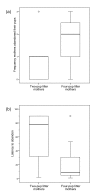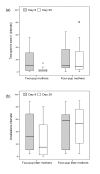Vocal mother-offspring communication in guinea pigs: females adjust maternal responsiveness to litter size
- PMID: 18783602
- PMCID: PMC2546386
- DOI: 10.1186/1742-9994-5-13
Vocal mother-offspring communication in guinea pigs: females adjust maternal responsiveness to litter size
Abstract
Background: In parent-offspring communication, vocal signals are often used to attract attention and offspring might call to induce parental behaviour. In guinea pigs (Cavia aperea f. porcellus) mothers wean larger litters later than small ones, but it is unknown whether this difference depends on processes induced during pregnancy or is influenced post-natally by the number of pups present. We here tested with playback-experiments using pup separation calls whether mothers with cross-fostered large experimental litters (four-pup-litters) were more responsive to offspring calls and maintained responsiveness for longer than mothers with small experimental litters (two-pup-litters). Mothers were tested when two pups were suckling i.e. when both teats were occupied.
Results: Mothers of four-pup litters responded stronger to broadcast pup separation calls than those with two-pup litters. Additionally, we tested the mothers' responsiveness to pup separation calls in the absence of their pups on day 8 and 20 of lactation. Mothers of four-pup litters responded stronger and showed no decrease in responsiveness from day 8 to 20, whereas mothers of two-pup litters responded less and decreased responsiveness from day 8 to 20. Mothers of four-pup litters also weaned their pups 5 days later than those of two-pup litters.
Conclusion: Measured by their response to pup calls and by time to weaning, guinea pig mothers adjust maternal responsiveness to litter size. This behaviour is likely to be an adaptive strategy in resource allocation during reproduction.
Figures




Similar articles
-
Mother is not like mother: Concurrent pregnancy reduces lactating guinea pigs' responsiveness to pup calls.Behav Processes. 2010 Jan;83(1):79-81. doi: 10.1016/j.beproc.2009.10.005. Epub 2009 Oct 29. Behav Processes. 2010. PMID: 19879338
-
Influences of climatic and social environment on variable maternal allocation among offspring in Alpine marmots.J Anim Ecol. 2021 Feb;90(2):471-482. doi: 10.1111/1365-2656.13380. Epub 2020 Nov 29. J Anim Ecol. 2021. PMID: 33155282
-
NTP technical report on the toxicity studies of Dibutyl Phthalate (CAS No. 84-74-2) Administered in Feed to F344/N Rats and B6C3F1 Mice.Toxic Rep Ser. 1995 Apr;30:1-G5. Toxic Rep Ser. 1995. PMID: 12209194
-
Effects of dietary dieldrin on reproduction in the Swiss-Vancouver (SWV) mouse.Environ Physiol Biochem. 1975;5(6):440-50. Environ Physiol Biochem. 1975. PMID: 1213033
-
Mother rabbits and their offspring: timing is everything.Dev Psychobiol. 2007 Jan;49(1):71-6. doi: 10.1002/dev.20196. Dev Psychobiol. 2007. PMID: 17186517 Review.
Cited by
-
Social calls provide novel insights into the evolution of vocal learning.Anim Behav. 2016 Oct;120:163-172. doi: 10.1016/j.anbehav.2016.07.031. Epub 2016 Sep 7. Anim Behav. 2016. PMID: 28163325 Free PMC article.
-
Parental Behavior in Rodents.Adv Neurobiol. 2022;27:1-53. doi: 10.1007/978-3-030-97762-7_1. Adv Neurobiol. 2022. PMID: 36169811
-
Neurophysiological Mechanisms of Mother-Young Bonding in Buffalo and Other Farm Animals.Animals (Basel). 2021 Jun 30;11(7):1968. doi: 10.3390/ani11071968. Animals (Basel). 2021. PMID: 34209286 Free PMC article. Review.
-
Rapid onset of maternal vocal recognition in a colonially breeding mammal, the Australian sea lion.PLoS One. 2010 Aug 13;5(8):e12195. doi: 10.1371/journal.pone.0012195. PLoS One. 2010. PMID: 20730045 Free PMC article.
-
Calling by domestic piglets during simulated crushing and isolation: a signal of need?PLoS One. 2013 Dec 13;8(12):e83529. doi: 10.1371/journal.pone.0083529. eCollection 2013. PLoS One. 2013. PMID: 24349527 Free PMC article.
References
-
- Kilner R. Mouth colour is a reliable signal of need in begging canary nestlings. Proc Roy Soc Lond B. 1997;264:963–968.
-
- Noirot E. The onset and development of maternal behavior in rats, hamsters and mice. Adv Stud Behav. 1972;4:107–145.
-
- Numan M, Insel TR. The neurobiology of parental behavior. Heidelberg, New York, Tokyo, Springer Verlag; 2003.
-
- Ottosson U, Bäckman J, Smith HG. Begging affects parental effort in the pied flycatcher, Ficedula hypoleuca. Behav Ecol Sociobiol. 1997;41:381–384.
-
- Södersten P, Eneroth P. Suckling and serum prolactin and LH concentrations in lactating rats. J Endocrinol. 1984;102:251–256. - PubMed
LinkOut - more resources
Full Text Sources
Miscellaneous

